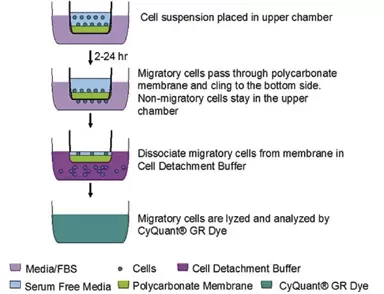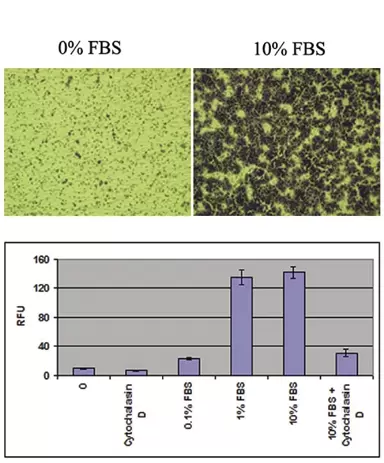CytoSelect™ 24-well Cell Migration Assay (8 µm), Colorimetric
| Specifications | |
|---|---|
| Product Category: | Cell Migration |
| Detection Method: | Colorimetric |
Product Description
- Fully quantify chemotaxis with no manual cell counting
- Measure chemotaxis in less than 6 hours with most cell types
- Membrane inserts are uncoated to allow use with any chemoattractant
Chemotaxis describes the movement of cells toward or away from a chemical stimulus in their environment. Cell chemotaxis plays a pivotal role in the progression of cancer and other diseases.
CytoSelect™ Cell Migration Assays are ideal for determining the chemotactic properties of cells. The 8 µm pore size is suitable for most cell types including epithelial cells, fibroblasts, and cancer cell lines.
Assay Principle

Fig.1. CytoSelect™ Chemotaxis Assay Principle. Migratory cells move through the polycarbonate membrane toward a chemoattractant underneath the membrane inserts.
Supporting Data

Fig.2. Migration of Human Fibrosarcoma HT-1080 Cells. Cells were seeded at 30,000 cells per well of a 24-well plate and allowed to migrate toward 10% FBS for 4 hours in either the presence or absence of 2µM Cytochalasin D. Migratory cells on the bottom of the polycarbonate membrane were stained (top) and quantified in a fluorescence plate reader (bottom).
Product Citations
- Afghani, N. et al. (2017) Microtubule actin cross-linking factor 1, a novel target in gliobastoma. Int J Oncol. 50:310-316.
- Colden M, et al. (2017) MicroRNA-466 inhibits tumor growth and bone metastasis in prostate cancer by direct regulation of osteogenic transcription factor RUNX2. Cell Death Dis. doi: 10.1038/cddis.2017.15.
- Yamauchi K, et al. (2017) Structure-Activity Relationships of Methylquercetin on Anti-migration and Anti-proliferation Activity in B16 Melanoma Cells. Anticancer Res. (4):1575-1579.
- Kestens, C. et al. (2016) BMP4 Signaling is able to induce an epithelial-mesenchymal transition-like phenotype in Barrett’s esophagus and esophageal adenocarcinoma through induction of SNAIL2. PLoS One. 11:e0155754.
- Kim, J. et al. (2016) Vimentin filaments regulate integrin–ligand interactions by binding to the cytoplasmic tail of integrin β3. J Cell Sci. 129:2030-2042.
- Catalog Number
CBA-100-CB - Supplier
Cell Biolabs - Size
- Shipping
RT

